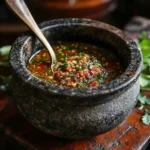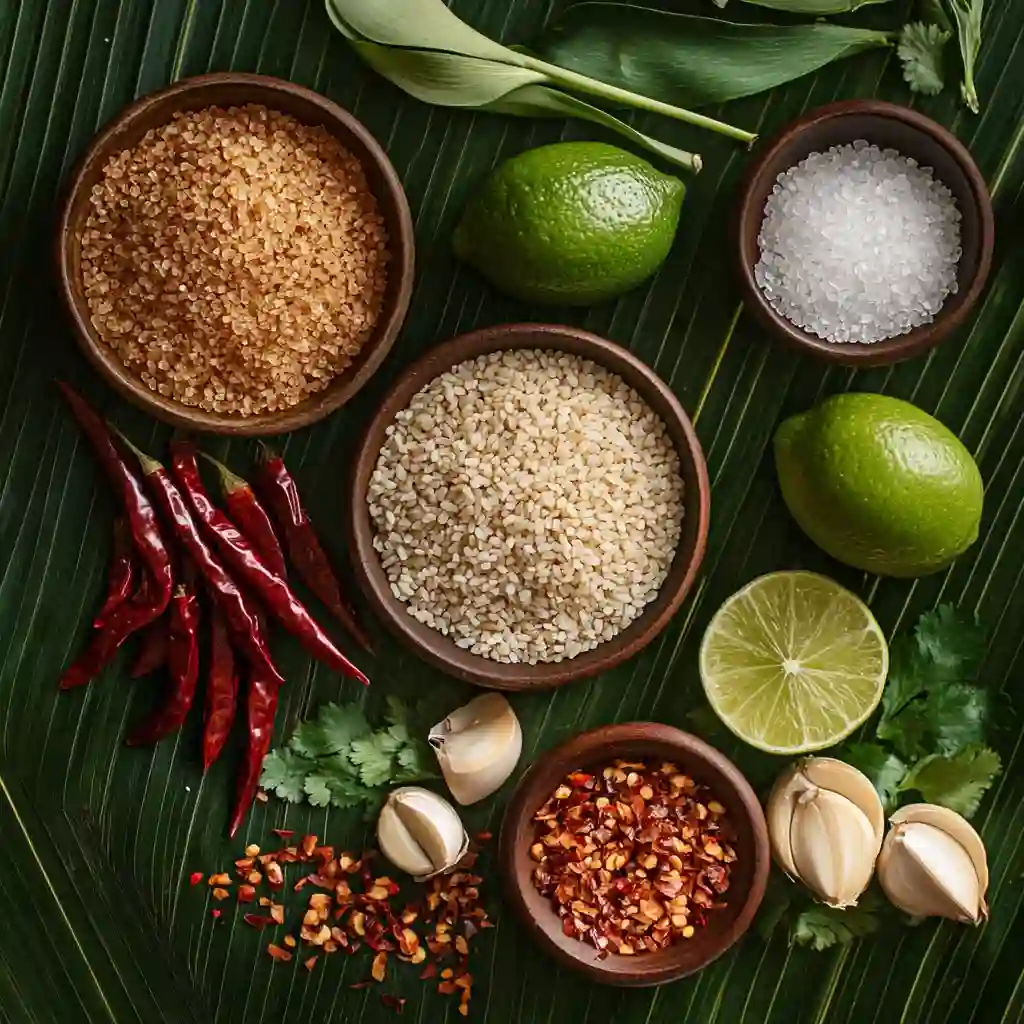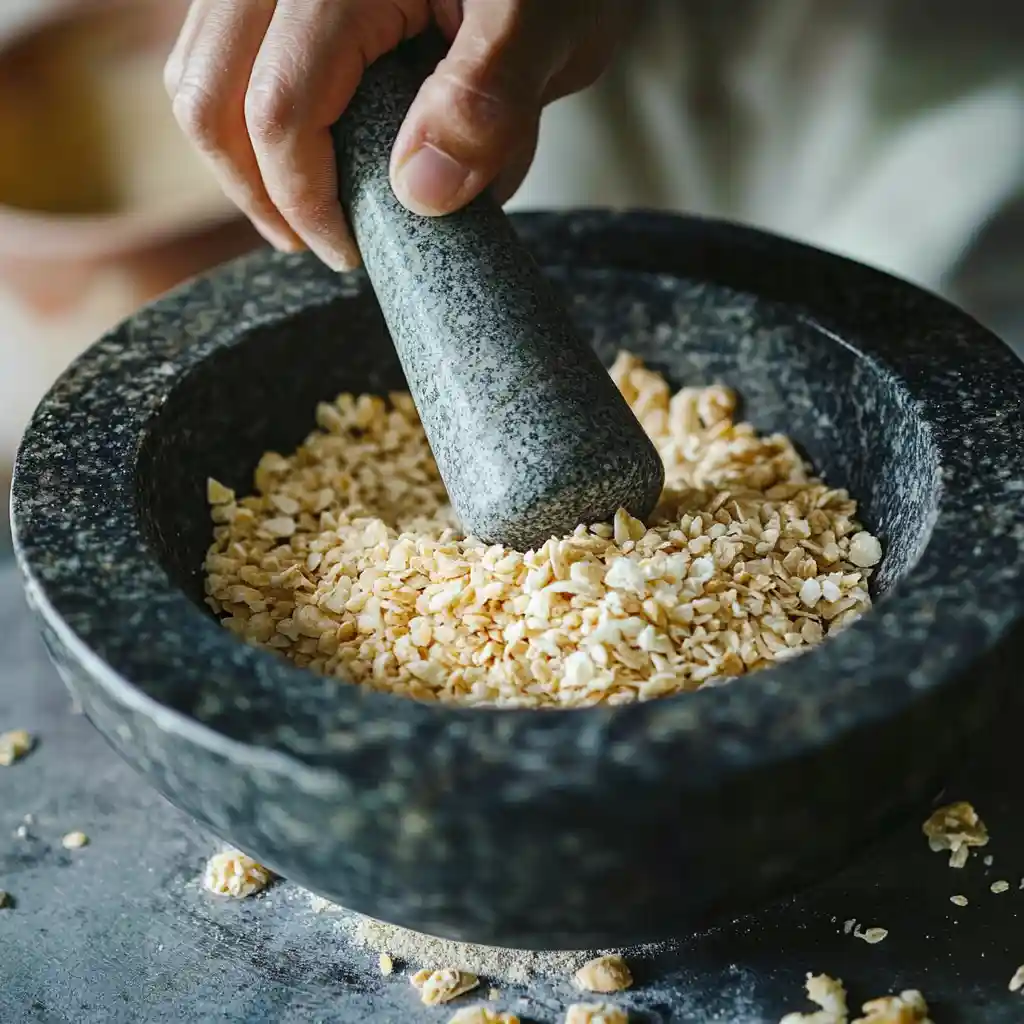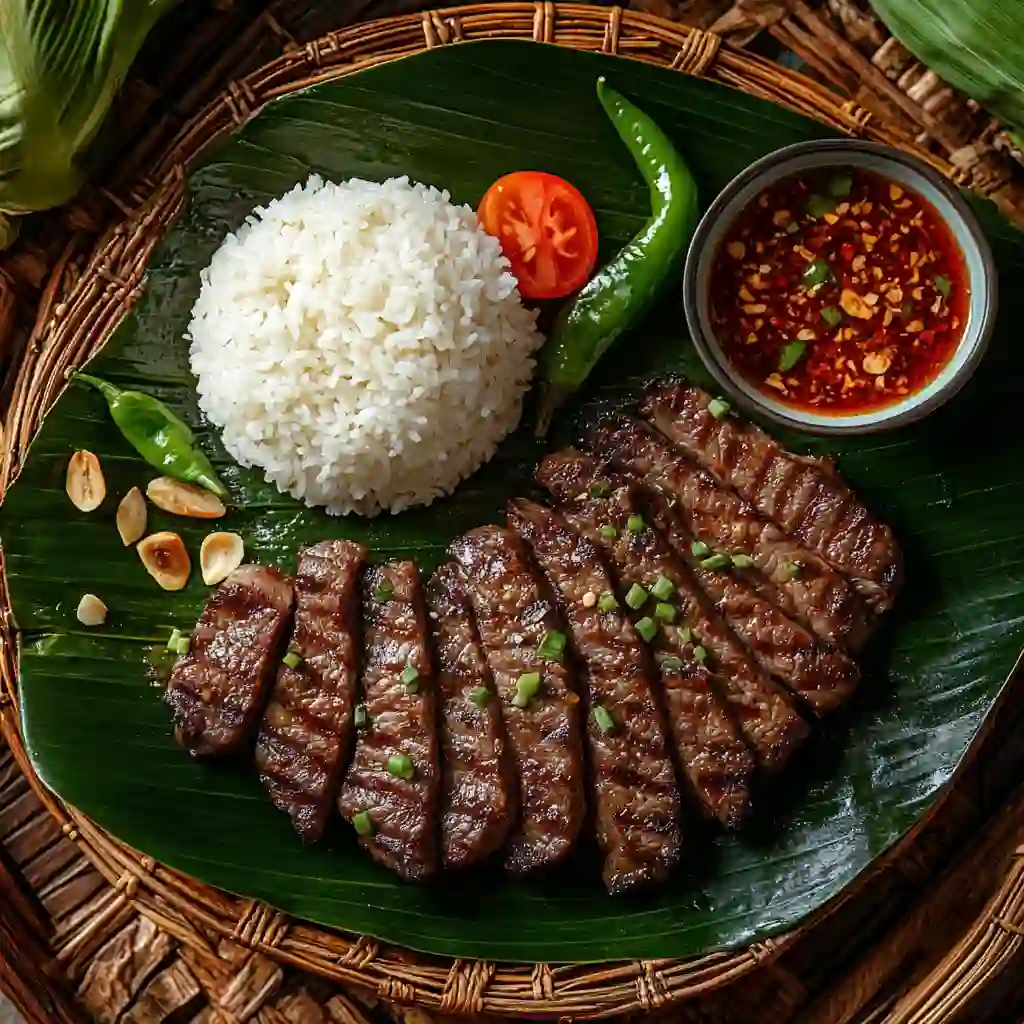From the first time I pounded toasted rice in my granite mortar, I knew this sauce would become a regular in my kitchen. Growing up in rural Virginia, I learned to cook by instinct alongside my mother. But it wasn’t until years later, while working in Asheville’s food scene, that I fell in love with Thai flavors. The thai dip made in mortar and pestle opened up a new world. It reminded me of my childhood bold, rustic, imperfect but absolutely packed with soul.
The sauce I’m talking about is Nam Jim Jeaw, a classic Thai dipping sauce that dances between smoky, spicy, and tangy. It’s traditionally paired with grilled meats, especially beef, and it’s made not blended in a mortar and pestle. That step is more than technique. It’s transformation. Pounding releases oils and aromas that knives and machines just can’t reach. The texture, a balance of crushed shallots, flecks of toasted rice, and vivid herbs, gives each bite something to hold on to.
In Thailand, the mortar and pestle is more than a tool it’s a kitchen companion. Whether you’re grinding curry paste or gently bruising garlic and chilies, this humble set does it all. For dips, the granite mortar excels. It crushes chili flakes and tamarind, emulsifies lime and fish sauce, and gives you full control over consistency. This hands-on method not only draws out flavor but connects you to tradition.
Whether you’re making a fiery Nam Jim for beef or a light, herb-forward variation for grilled chicken, using a mortar and pestle keeps the flavors bold and real. And if you want to round out your Thai meal, you might pair this sauce with recipes from our sauces collection or smoky meats from our beef.
Table of contents

Thai Dipping Sauce for Meat Made in Mortar and Pestle
- Total Time: 20 minutes
- Yield: 4 servings 1x
Description
Bold, smoky Thai dipping sauce made in a mortar and pestle. Perfect with grilled meat and sticky rice. Quick, balanced, and packed with real flavor.
Ingredients
“Original” All-Purpose Nam Jim Jeaw
1 tablespoon jasmine rice or glutinous rice, uncooked
2 tablespoon tamarind paste
1 tablespoon fish sauce
1 tablespoon lime juice
1 tablespoon palm sugar, finely chopped, packed
2 tablespoon finely diced shallots
1 teaspoon toasted chili flakes, or to taste
3 tablespoon chopped herbs such as cilantro, green onions, mint, or sawtooth coriander
Light Nam Jim Jeaw
1 tablespoon jasmine rice or glutinous rice, uncooked
2 tablespoon fish sauce
1 ½ tablespoon lime juice
1 tablespoon tamarind paste, or sub another ½ tablespoon lime
1 teaspoon sugar
1 teaspoon toasted chili flakes, or to taste
2 tablespoon minced shallots
3 tablespoon chopped herbs such as cilantro, green onions, mint, or sawtooth coriander
Mellower Tomato Jeaw
1 recipe All-Purpose Nam Jim Jeaw (above)
⅓ cup small diced juicy tomatoes
Instructions
1. Toast the rice in a dry skillet over medium heat until golden and fragrant. Let cool.
2. Grind the toasted rice in a mortar and pestle until coarse but not powdery.
3. Add chili flakes and pound briefly to combine with the rice powder.
4. Add palm sugar and pound until dissolved slightly.
5. Pour in tamarind paste, fish sauce, and lime juice. Mix with the pestle to emulsify.
6. Stir in diced shallots and chopped herbs gently to preserve texture.
7. (For Light Version) Use lighter ratio of lime and sugar. Mix all ingredients the same way.
8. (For Tomato Jeaw) Fold diced tomatoes into the finished Nam Jim Jeaw.
9. Taste and adjust lime, fish sauce, or sugar as needed. Serve immediately.
Notes
Nam Jim is best served fresh. You can refrigerate it up to 3 days, but the herbs will lose some brightness. Use with grilled meats, roasted vegetables, or sticky rice. For extra heat, increase chili flakes.
- Prep Time: 15 minutes
- Cook Time: 5 minutes
- Category: Sauces
- Method: Mortar and Pestle
- Cuisine: Thai
Nutrition
- Serving Size: 2 tbsp
- Calories: 35
- Sugar: 3g
- Sodium: 350mg
- Fat: 1g
- Saturated Fat: 0g
- Unsaturated Fat: 0.8g
- Trans Fat: 0g
- Carbohydrates: 5g
- Fiber: 0.5g
- Protein: 1g
- Cholesterol: 0mg
Understanding Thai Meat Dips (Nam Jim Variations)
When someone in Thailand grills meat, a bowl of Nam Jim isn’t far behind. The most iconic? Nam Jim Jaew, the smoky-sour chili sauce born in the Isan region. It’s deeply flavored with toasted rice, tamarind, and chili flakes — always made by hand, often still warm from the pestle. This nam jim sauce hits all the right notes: salty, sour, spicy, and just enough sweetness to round it out.
What makes Nam Jim Jaew especially satisfying is the texture. The crushed toasted rice gives it a nutty crunch, while the finely diced shallots soften in the acidic lime juice. No two versions are alike — some lean heavier on the tamarind, others turn up the chili heat. But it always has a balance that keeps you coming back. This sauce wasn’t designed in a lab. It was built at backyard barbecues, roadside stalls, and home kitchens with mortar and pestle in hand.
Then there’s Tomato Jeaw, a milder variation that builds on the same foundation but adds juicy diced tomatoes. It mellows the sauce and makes it more versatile — think roasted chicken or even fried tofu. And let’s not forget Seafood Nam Jim, brightened with garlic and green chilies, thinned for dipping shrimp or steamed fish. The mortar still plays a central role here. It helps crush those chilies just enough to release oils without turning everything into mush.
Each variation of Nam Jim sauce reflects a region or a personal taste. That’s what makes them special they’re adaptable. If you’re planning to serve it with grilled steak, visit our grilled meats section, or if seafood is on your plate, pair it with one of our top seafood dishes.
With just a few tweaks, one base sauce becomes three — all made better with the rhythmic crush of pestle against stone.
Essential Techniques for Making Nam Jim by Hand
If you’ve ever tasted Nam Jim dipping sauce and wondered what gives it such bold flavor and perfect texture, the answer lies in the tool: the mortar and pestle. This humble setup gives you total control over every ingredient, from the crispness of the shallots to the way the toasted rice cracks under pressure. For Thai sauces like these, the process matters just as much as the ingredients.

First, choose the right mortar. Granite mortars are the go-to for Nam Jim Jeaw and other hearty dips. Their rough surface helps grind everything from chili flakes to tamarind pulp with minimal effort. While clay mortars are great for salads like som tam, granite provides the heft you need to fully release flavor — especially in the nam jim dipping sauce where texture is layered, not smooth. If you’re curious about these tools, explore more in our guide to essential Thai kitchen techniques.
Start with dry ingredients. Toast your jasmine or glutinous rice in a dry pan until golden, then grind it in the mortar into a coarse powder. This gives the sauce body and a hint of smokiness. Next, add your chili flakes — these can be homemade or store-bought but should always go in early to blend with the rice powder.
From here, work in the wet ingredients: palm sugar, tamarind paste, lime juice, and fish sauce. The pestle helps emulsify them, breaking down sugar and integrating the sour, salty, and sweet flavors completely. Then fold in minced shallots and fresh herbs like cilantro or mint. The final product shouldn’t be watery or overmixed — it should look alive, dotted with herbs and streaked with red and brown.
When you craft a Thai sauce this way, you’re not just combining flavors — you’re coaxing them out. And once you’ve made your first Nam Jim by hand, you’ll never reach for a bottled sauce again.
For more spice-layered sides that pair well with this, explore our ingredient techniques or learn how to prepare sticky rice — the perfect companion to a good jeaw.
Making Your Own Thai Dipping Sauce at Home
Now that you understand the flavor power of Nam Jim, it’s time to make it yourself. Crafting a Thai dipping sauce for meat in your mortar and pestle isn’t just satisfying — it’s fast, fresh, and wildly flavorful. Whether you’re firing up the grill or searing steak indoors, a bowl of Nam Jim elevates every bite.

Start with the Original All-Purpose Nam Jim Jeaw. Begin by toasting a spoonful of jasmine rice until golden and fragrant. Let it cool, then crush it in your mortar into a coarse powder. This gives the sauce its signature crunch and deep aroma. Add toasted chili flakes and palm sugar next. Pound just until combined, then stir in tamarind paste, lime juice, fish sauce, and chopped shallots. Finish with fresh herbs like cilantro or mint. The flavor should be balanced — tangy, smoky, sweet, and just enough fire.
For a lighter version, swap the palm sugar for a small amount of white sugar and dial back the tamarind. You’ll get a thinner, brighter sauce that pairs perfectly with lean grilled beef or roast chicken. If you’re working with grilled seafood or crispy tofu, the Mellower Tomato Jeaw adds soft acidity and body, thanks to juicy diced tomatoes folded in at the end.
This sauce keeps for a few days in the fridge, but it’s best made fresh. The herbs wilt and lose punch over time, so only make what you’ll use. Serve it at room temperature alongside sticky rice, grilled meat skewers, or roasted veggies. For a full Thai-style meal, pair it with our chicken satay, grilled seafood, or go bold with Thai beef dishes.
Don’t forget to use your mortar again soon. These sauces come together in minutes, and each batch can reflect what you have on hand or how spicy you’re feeling that day. Once you’ve made a few variations, you’ll never run out of ways to pair Thai dipping sauce for meat with your favorite dishes.
FAQs About Thai Dipping Sauce for Meat
Nam Jim is a family of Thai sauces that typically blend fish sauce, lime juice, palm or white sugar, chili flakes, garlic, and fresh herbs. Some versions include toasted rice powder or tamarind paste for added complexity and depth.
To make a Thai fish dipping sauce (Nam Jim Seafood), crush garlic and bird’s eye chilies in a mortar, then stir in lime juice, fish sauce, sugar, and optionally a bit of water or vinegar. It should taste sharp, spicy, and slightly sweet — perfect for grilled or steamed fish.
Nam Jim Seafood, also called Nam Jim Talay, is the most popular. It combines chilies, garlic, lime, sugar, and fish sauce. You can tweak the ratios based on how spicy or sour you want it. Try it with steamed shrimp, grilled squid, or mussels for a fresh coastal flavor.
Jeow Som is a Lao-Thai dipping sauce that’s heavy on lime juice, garlic, fermented fish sauce, and crushed chili. Often made in a clay mortar, it’s thinner than Nam Jim Jaew and designed to cut through fatty meats or fried dishes.
Conclusion
Thai dipping sauces aren’t just condiments they’re expressions of flavor, culture, and craft. Whether you’re pounding toasted rice into smoky Nam Jim Jaew or mixing tomatoes into a mellower jeaw, doing it by hand with a mortar and pestle brings out something electric. You don’t need fancy tools just a granite bowl, a pestle, and a few bold ingredients.

And if you’re looking to serve your Thai dipping sauce for meat with something memorable, explore our sides and rice pairings or find the perfect protein in our grilled recipes.
Once you’ve made Nam Jim once, it won’t be your last. And like I always say once you crush your first batch by hand, you’re not just cooking. You’re connecting.

